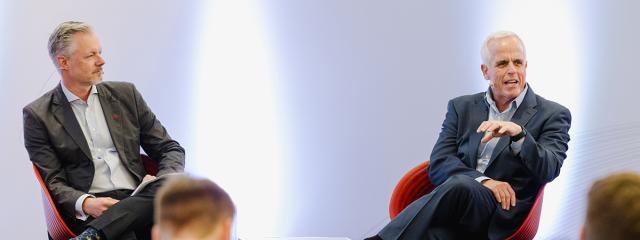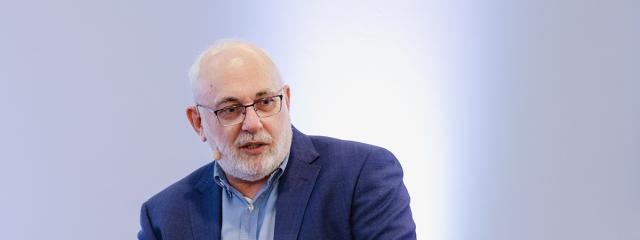Matthew Parker-Jones on a team Canada approach to payments
We recently spoke to newly appointed Payments Canada Board Member Matthew Parker-Jones about his passion for payments. He shared his priorities as Senior Vice President, Global Transaction Banking at Scotiabank, as well as the importance of taking a collaborative, team Canada approach to delivering broader payment capabilities that keep pace with global peers.
Senior Vice President, Global Transaction Banking
Scotiabank
First, congratulations on your appointment to the Payments Canada Board of Directors. Can you talk about what drew you to the position?
Thank you so much, it’s a privilege to join the Board.
What drew me to the Board was a combination of three things: First, I am very passionate about payments — it is a truly universal product and something that every Canadian can relate to. We all use it in our day-to-day lives. We all get paid, we all make payments, we all buy cups of coffee, pay for Netflix, pay our rent and/or our mortgage. It's something that everyone understands inherently and there's something powerful and democratizing about that.
Second, I've been engaged with Payments Canada for many years in various capacities. I previously sat on the Member Advisory Council and other industry committees, where I became very familiar with the major issues and opportunities that we are trying to tackle as an industry. I believe it is vital for Canada to remain a global leader in the payment sphere and that Payments Canada plays a critical role in that story.
Finally, we are at an important watershed moment for our country as we move forward in our journey to modernize the payment ecosystem. I spoke at The 2024 Payments Canada SUMMIT about Canada being at a crossroads and I genuinely believe so. We've had our bumps along the way in the last few years, but it's now about driving forward. We need to get back to leading and transforming Canada’s payment space and making sure we've got the right infrastructure in place to continue being a vibrant, productive economy.
Having worked at global banks and now leading our payment products at Scotiabank, I am looking forward to contributing and helping ensure that we build a payment infrastructure that we are not only proud of as a country, but that also propels us to new heights amongst our global peer group.
You mentioned your role at Scotiabank. What are the current payment priorities there?
Payments are a very important part of Scotiabank and a key priority in our enterprise strategy under the leadership of our President and CEO, Scott Thomson. Payment excellence is key to winning primary client relationships, which will help us to become our clients’ most trusted financial partner.
Within Global Transaction Banking at Scotiabank, we have four major priorities that underpin our strategy. First, we're focused on making sure we've got great payment and cash management products in all of our markets. We need to ensure we're offering the right products to support our clients, whether it’s a small business in Canada, or a large multinational client operating across our entire footprint — this includes expanding our cash management capabilities in the United States, which is a big focus for us. As a multinational bank, I am very lucky that I get to see what’s happening in payments from Toronto to Santiago, which makes every day very dynamic.
Our second priority is to connect our markets to make it easier for clients to do business with us. For instance, think of an auto manufacturer that has operations across the free trade corridor between Canada, Mexico and the United States — my job is to make sure it is as easy as possible to collect, manage and send money across those three jurisdictions. This is where initiatives like ISO 20022, which Payments Canada has been championing, are extremely important because they provide a common messaging standard, or language, for payments. Making sure that Canada is ‘at the table’ for these initiatives is important, as it ensures our participation and relevance in the global economy by removing friction from international trade flows.
The other areas we're focused on are resiliency and stability. To that end, cybersecurity is top of mind for us, and we are making sure that everything we do is safe and sound. We spend significant time and investment ensuring that we have world-class cyber security, fraud protection and stability to safeguard our clients’ payment activities.
Lastly, we remain firmly client-focused throughout all of this. I always advise my teams not to build a product and hope the clients come. Make sure that you're building products together with your clients and that you're collaborating and innovating with them.
Our payment strategy is about making sure we've got great products in our clients' hands, deepening connectivity across our vast footprint, and doing so in a safe and client-centric manner so that we're creating value.
What do you think are some short-term actions we can take to ensure Canada remains a vibrant and attractive payment environment? What about in the long term?
This topic is near and dear to me, and I can think of a few actions. Part of our Canadian psyche is that we can be somewhat inward-looking; we tend to compete, contrast and compare ourselves within our own backyard. It’s very important that we continuously look up and see what's happening outside of our borders. It serves as a healthy reminder that there is great innovation and great lessons learned, but also that we compete as a country in the global economy.
Second, it is one thing to have a great idea, but 90% of success — if not 99% — is in execution. Results matter. Execution is where we have struggled sometimes as a country and that has contributed to delays on key industry initiatives. We need to make sure that we're laser-focused on getting the job done, while also celebrating our successes as we do so.
When you spoke on the main stage at The 2024 Payments Canada SUMMIT, you called for collaboration among the payment community. More specifically, the payment industry in Canada needs to operate like team Canada. How will this mindset benefit the payment ecosystem?
We have to lift our heads up and realize that Canada is one country in a large global economy. We have to be thinking about how we compete and how we show up as Canadians. Payment infrastructure is critical for our economy to function and to attract foreign investment. It is also an important criteria when technology companies, banks and other international firms choose where they're going to deploy their capital and where they're going to build businesses.
It's important for us to make sure that we're operating as a country. That means working together to provide a robust payment environment and limit barriers to entry by making it as easy as possible to connect and use our payment systems. In my opinion, that will result in the pie growing for everyone versus debating as to how that pie is sliced. If the pie is growing, people stop thinking as much about what the size of their slice is, because everybody is benefiting. I think that a change of perspective, taking a team Canada approach, and thinking about “how do we grow the pie for everybody?” will be to the country's benefit.
Over the past few months, the payment industry in Canada has begun collaborating more as “one team” and we're seeing some early success now as we get back on track for the Real-Time Rail.
Is there anything else you’d like to share with our readers?
It is a really exciting time for Payments Canada and for payments in Canada. I believe everyone should feel a high degree of optimism. Looking ahead, the future of payments in the country holds great promise as we continue to enhance our ecosystem with advancements in technology, infrastructure and policies to deliver more efficient payment solutions.
Matthew’s keynote address and other main stage content is available on demand.




